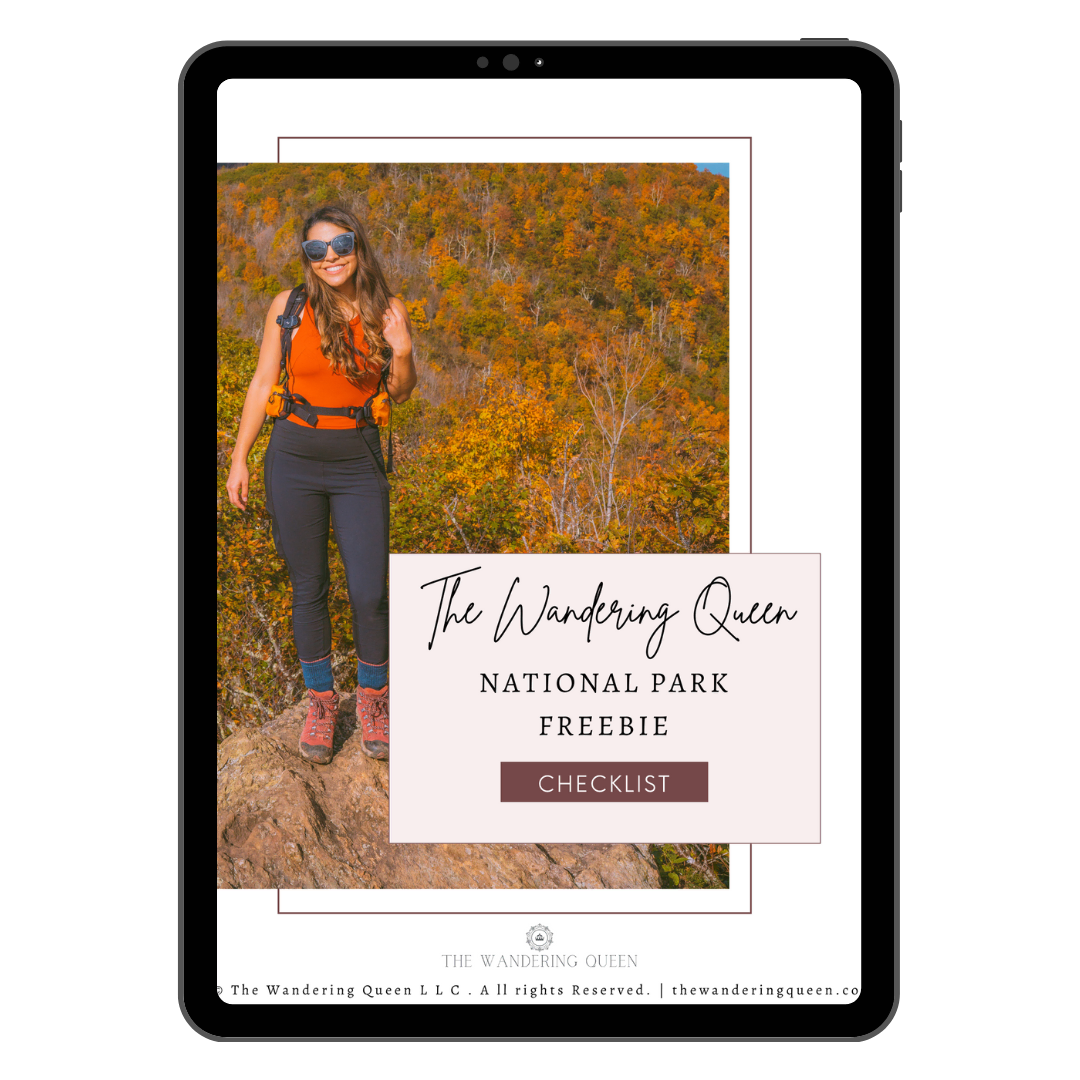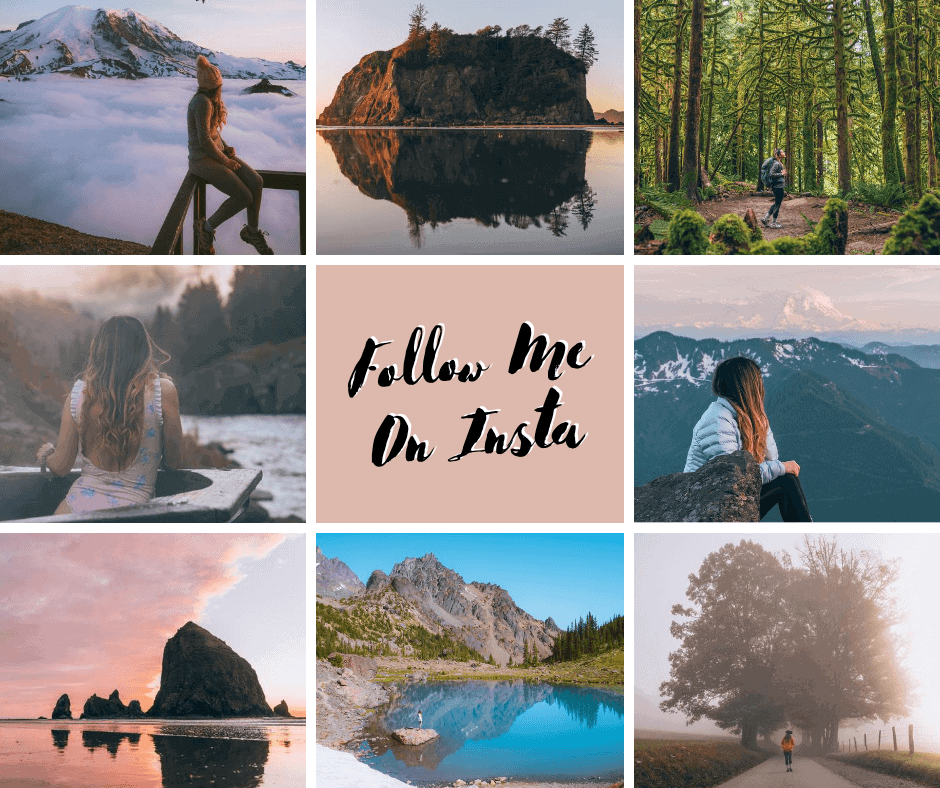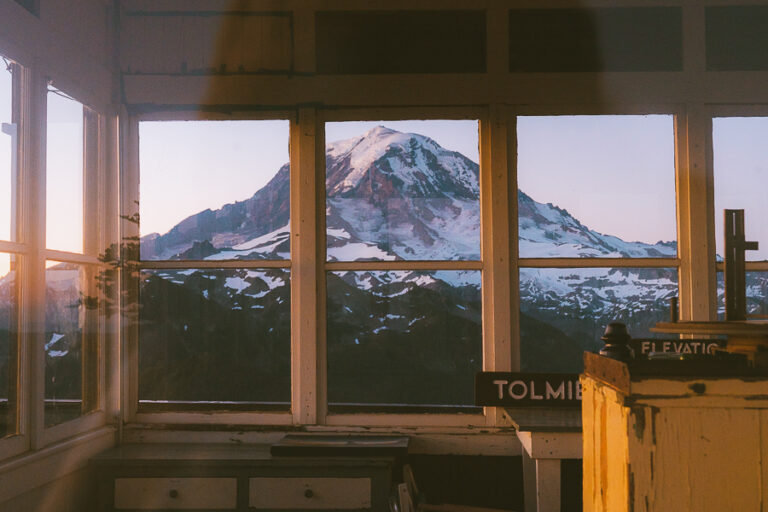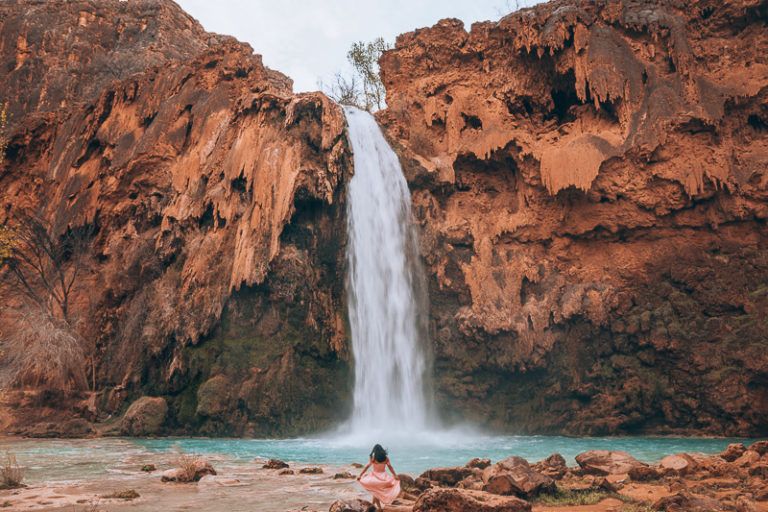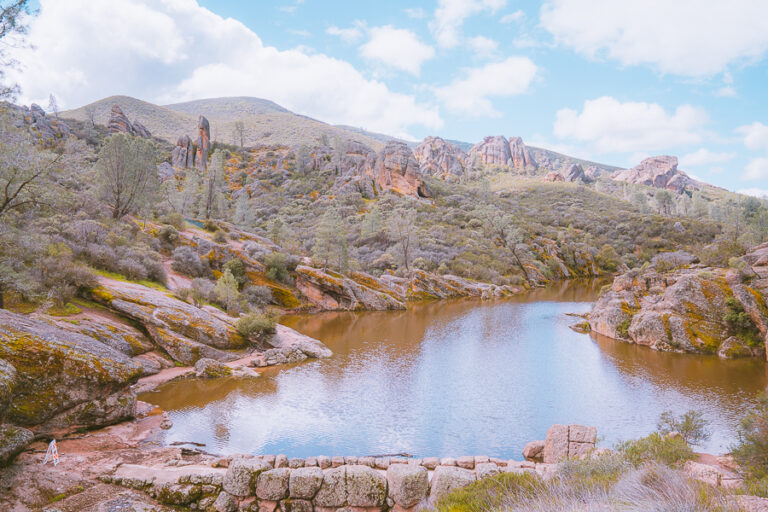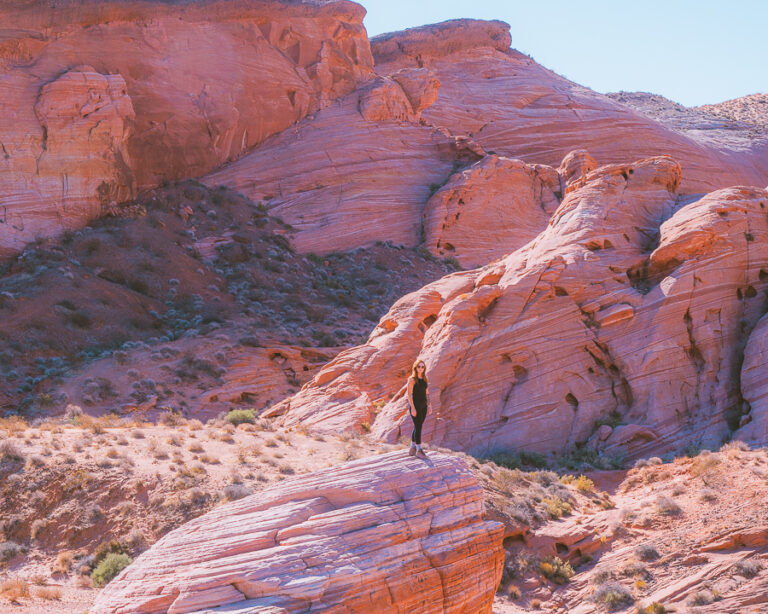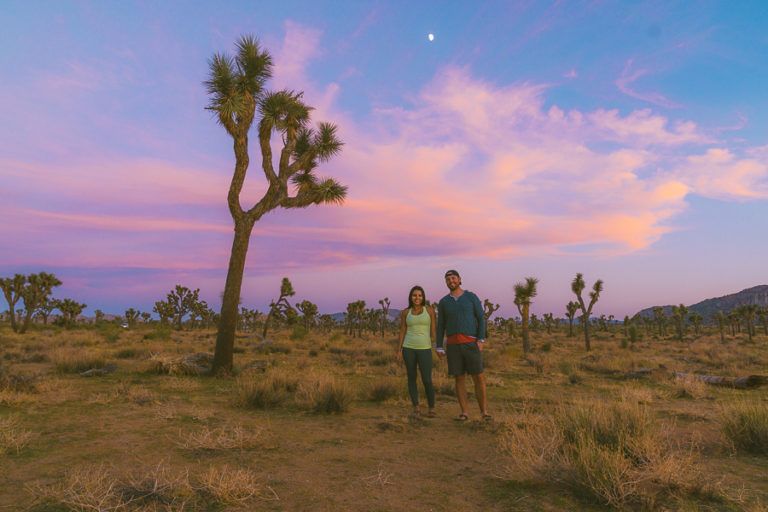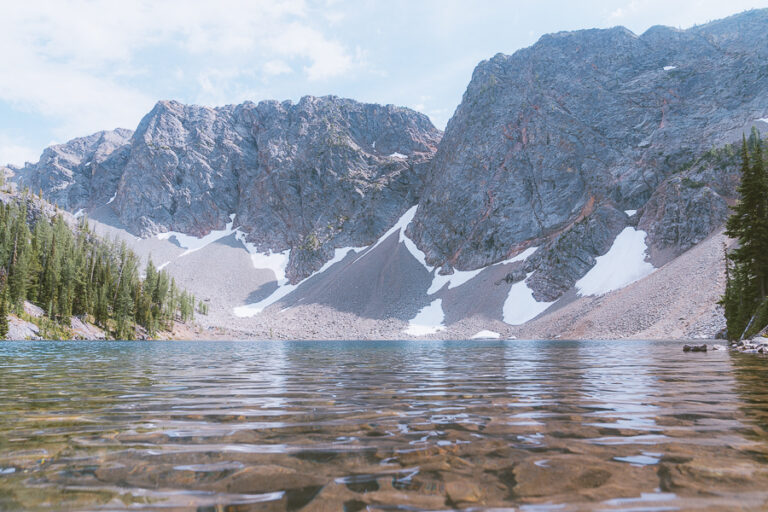One Day in Grand Canyon | Sights, Planning & Tips
Carved by the Colorado River over millions of years, the natural wonder of the Grand Canyon exemplifies the Earth’s geological history. Located in northern Arizona, the iconic national park’s size and intricate rock formations continue to draw visitors from all over the world.
Visiting the Grand Canyon is a once-in-a-lifetime experience that promises to deliver spectacular natural beauty and thrilling adventure. Whether you’re a nature lover, hiking enthusiast, or simply in search of a tranquil escape from the bustle of daily life, you’re bound to find something that will excite you here.
Now, it’s not always possible to spend a couple of days in nature, as much as we’d love to. Never fear; I’ve compiled this handy guide to help you uncover the best-kept secrets of Grand Canyon National Park in just one day. Read on for my tips and recommendations for the perfect one-day trip to the Grand Canyon.
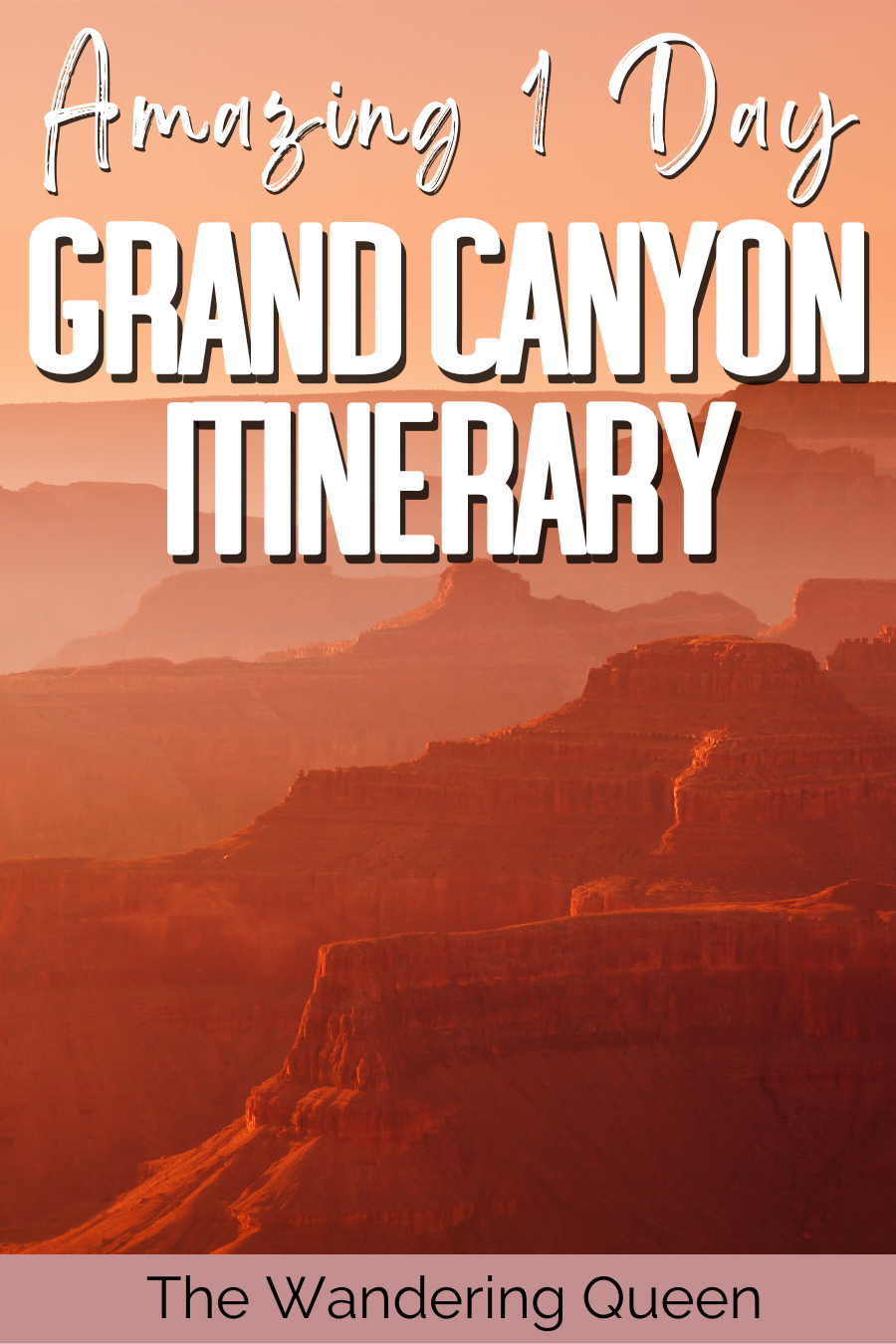
Disclosure: This post contains affiliate links. If you click one of them, I may receive a small commission (for which I am very grateful for) at no extra cost to you.
Grand Canyon National park
Related Posts
Map of Grand Canyon in A Day
The Ultimate One-Day Grand Canyon Itinerary | Top Things to See & Do
There is so much to see and do in the Grand Canyon National Park that you’d think it impossible to spend only a day there. You don’t have to worry, though. Below, you’ll find some of the top attractions to make your one-day Grand Canyon itinerary a piece of cake.
Watch the Sunrise at Mather Point
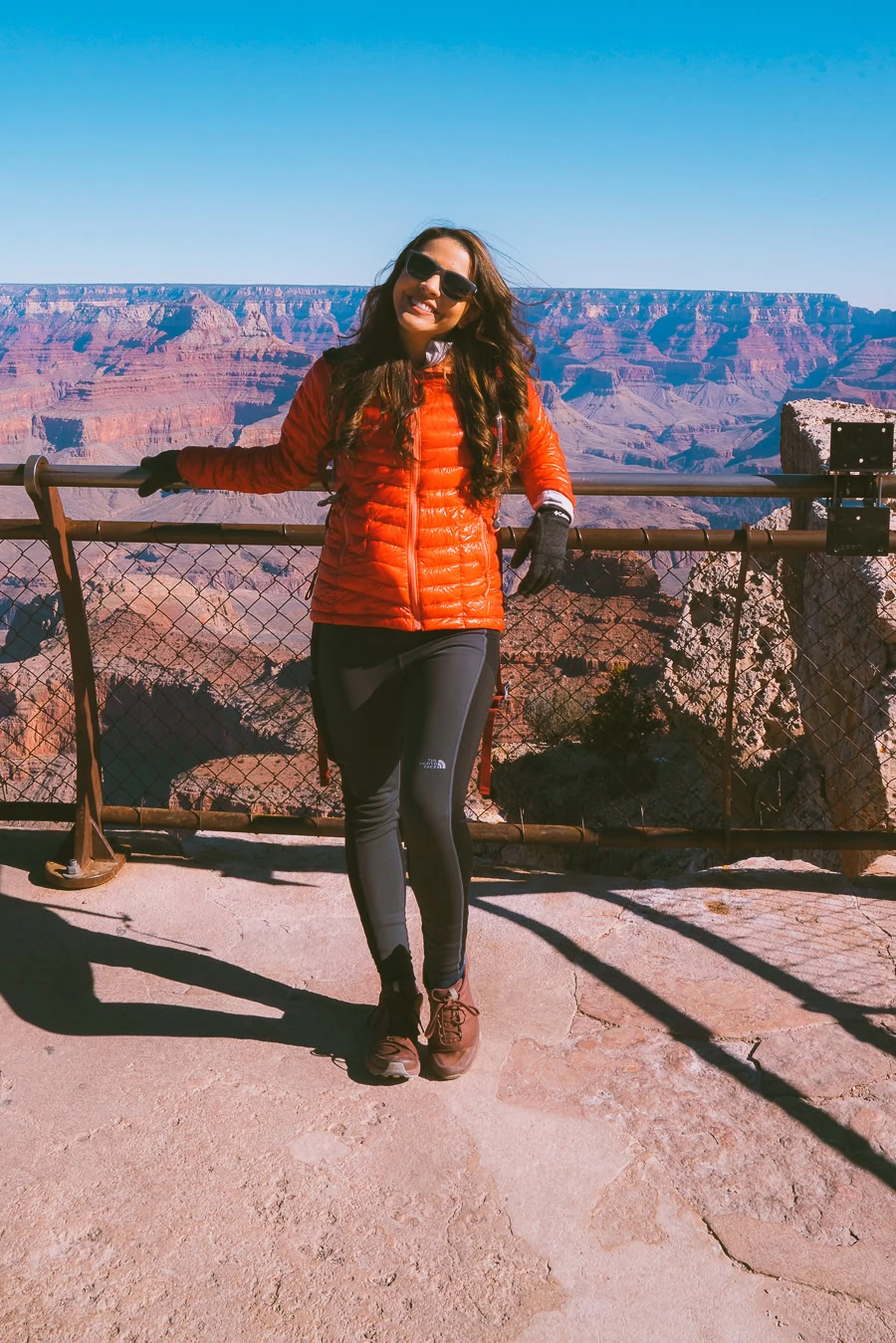
Watching the sunrise at Mather Point is a must-do for visitors, so make sure you start your Grand Canyon day trip early. Located near the main visitor center on the South Rim, Mather Point is famous for its awe-inspiring views over the vast expanse of the canyon.
The spectacle of the first rays of light and moving shadows slowly changing the colors on the rock formations will be something you’ll never forget. The short stroll you have to take to get here is worth every step.
Mather Point is one of the most popular scenic viewpoints in the park and does get crowded, so make sure you get in before the rush to get the best spot to drink your morning coffee and watch the most breathtaking sunrise you’ll ever see.
Check Out the Grand Canyon Visitor Center
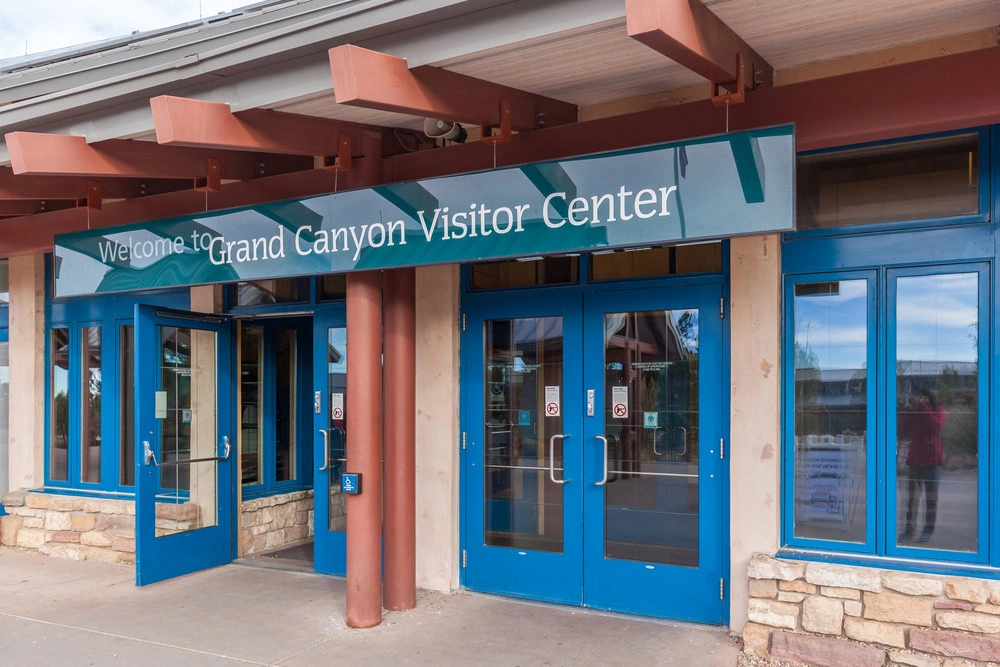
The Grand Canyon Visitor Center serves as the main hub for visitors to the national park. Located along the South rim of the canyon, the center offers a variety of services and facilities to enhance your Grand Canyon experience.
Here, you can learn about the park’s colorful history, fascinating geology, and wildlife through exhibits and amazing ranger-led programs. One of its selling points is the stunning panoramic views you’ll find from here. You’ll be able to step out onto one of the observation decks and marvel at the vistas with wonder.
This is the main visitor center, offering amenities such as restrooms, a bookstore, and a gift shop where you can pick up a souvenir or a park map.
This is also the starting point for the shuttle bus, which travels through the area, stopping at many of the South Rim viewpoints. The shuttle bus also provides easy passage to some of the South Rim trails along the way.
Hike Part of the Rim Trail
- Mileage: 12.7 miles point-to-point
- Elevation Gain: 584 feet
- Difficulty: Moderate
- Trail Guide: Link

The Rim trail is one of the best hiking trails in the Grand Canyon National Park. It stretches along the South Rim, with numerous access and viewpoints dotted along the way.
You’ll take the orange shuttle route to the South Kaibab Trailhead to get started. This moderately challenging trek takes an average of four and a half hours to complete. The trail ends at Hermit’s Rest.
As you walk along the mostly paved trail, you’ll be wowed by the scenic viewpoints offering vistas of the canyon extending for miles. Hopi Point and Mohave Point are particularly popular for their lookouts over the canyon.
There are multiple shuttle stops along the way, so you’ll be able to curate your hike along this trail to suit your taste and time requirements. There’s no water along the trail, so make sure you bring your own bottle.

Tip: Don’t want to hike? Hop on this amazing helicopter tour for a bird’s eye view of the Grand Canyon.
Visit Yavapai Point
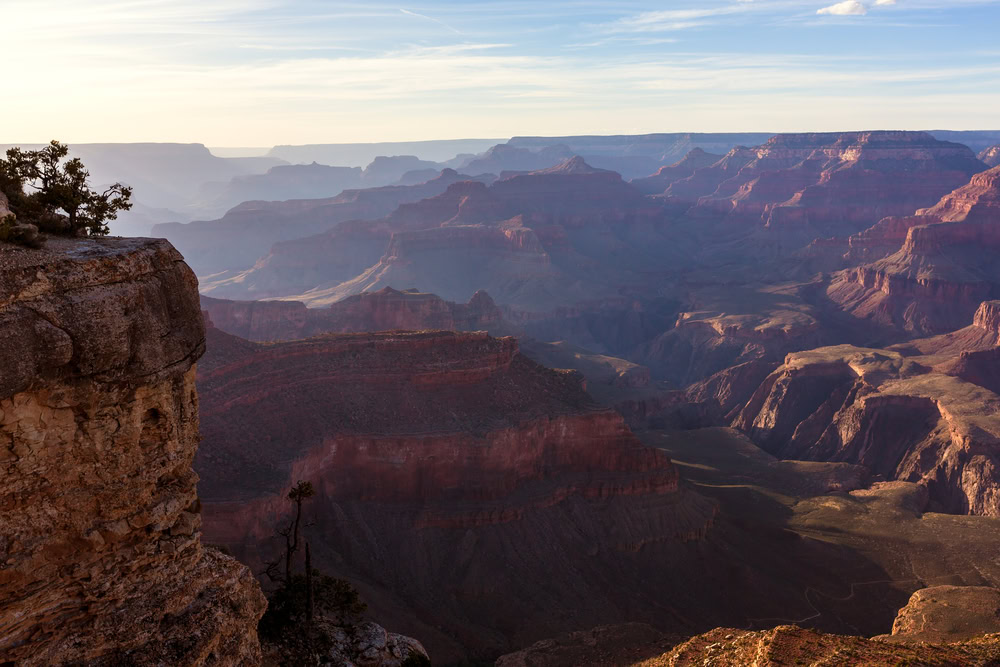
Another South Rim gem, Yavapai Point, features stunning panoramic views of both the Grand Canyon and the Colorado River rushing below the lookout point. It is popular at any time of day, whether you want to catch the sunrise, see the full beauty of the canyon during the day, or bask in the golden rays of sunset.
Adjacent to the point is the Yavapai Geology Museum, a haven for all things Grand Canyon. The museum features exhibits explaining the formation of the canyon over millennia, showing the various layers and processes that came together to form this geological masterpiece.
A visit to both the point and the museum is unmissable for anyone fascinated by the Grand Canyon (who wouldn’t be?).
Pop in at Verkamp’s Visitor Center
You might wonder what a visitor center could possibly have to entice you, but trust me when I say you don’t want to skip this one. Housed in a historic building that was once a pioneer shop, Verkamp’s visitor center is a showcase of the history of the Grand Canyon and its tourist legacy. The center features artifacts and photographs displaying the 19th and 20th-century culture and flair of the area.
There are also displays on the geology of the site and Native American history. You can also join a ranger program or guided walk to experience all the center has to offer.
Explore Hermit Road

Traversing this scenic route is one of the things to do at Grand Canyon’s South Rim. Home to some of the canyon’s most breathtaking views, you’ll encounter spots like Mohave Point, an outlook with views to die for.
Powell Point provides a unique perspective of the Colorado River’s path through the canyon, while Hopi Point is particularly famous for its sunrise and sunset vistas.

The road is closed to private vehicles through most of the year, but you can easily tour it on a bike, hike, or by the ever helpful shuttle. If you’d like to see these viewpoints during the coveted golden hour, you might want to book this guided sunset hummer tour.
Hike the South Kaibab Trail to Ooh Ahh Point
- Mileage: 1.8 miles out and back
- Elevation Gain: 686 feet
- Difficulty: Moderate
- Trail Guide: Link

This short and sweet trail provides one of the best day hikes in the Grand Canyon. Considered the halfway point to Cedar Ridge, this beautiful hike is worth the sweat. It does pose a slight challenge but is manageable enough that kids can do it, too.
The downhill to the point is sometimes a little steep, so make sure you have good shoes and a pole if you need it. The views of the canyon’s layers from this lookout make it easy to see why it was named Ooh Aah Point. Your best bet is to go early or late in the day, as the trail is quiet, so you can escape the crowds and the heat.
There’s no parking at the South Kaibab Trailhead, so I’d suggest taking a shuttle from the main visitor center. Look at the shuttle bus schedule to plan your hike.

Note: You can extend this trek to Skeleton Point, but that will be an extra four miles to the hike.
See Yaki Point
If you’re looking for phenomenal views, Yaki Point will blow your mind. Renowned for its vast vistas and the color changes on the rock caused by the movement of the sun, this viewpoint will show you all of the canyon’s beauty.
Unlike some other viewpoints along the South Rim, Yaki Point isn’t accessible to private vehicles. To visit, you’ll have to hop on the park’s free shuttle bus, which stops at the viewpoint on its route. The shuttle makes it easy for visitors to access this overlook without the hassle of parking.
Claim your FREE Hiking Checklist
Ready to start hiking? Grab my free hiking checklist and never forget anything at home!
Visit the Tusayan Ruins

Nestled near the South Rim, the Tusayn Ruins are an exciting expedition into the history of the Puebloan people. These ancient ruins date back to around 1185–1225 AD and consist of a small village with a ceremonial kiva, a plaza, and living quarters.
There are also reconstructed structures that lend substance to the idea of what the village may have looked like when it was inhabited. You can follow the signs and explore the history and culture of the site’s creators.
There is also the nearby Tusayan Museum which you can visit for further insight into the Puebloans. There are exhibits and interpretive displays to enrich your experience and teach you more about the people who are a part of the history of the Grand Canyon.
Climb the Desert View Watchtower

This historic landmark might have the best Grand Canyon views you’ll find. The Desert View Watchtower was designed by architect Mary Colter and completed in 1932. The tower was inspired by ancient Puebloan watchtowers, and the breathtaking views from this site are unmatched.
You definitely want to climb to the upper levels of the tower to get the best spot to take some photos. Inside the watchtower, you’ll find informative displays about the tower’s history and construction. You’ll also find beautiful murals by Hopi artist Fred Kabotie as well as a gift shop to grab some souvenirs of your trip.
Read More: Hiking in the Desert | Tips, Tricks & Travel Essentials
Best Time to See the Grand Canyon

The best time to see Grand Canyon National Park depends largely on your preferences and intentions for visiting this magnificent site.
The nicest times to visit are in Spring (March to May) and Fall, which is between September and November. The weather is mild, and the crowds are much smaller compared to the summer months, which is the peak season.
During these seasons, the temperature is ideal for hiking, and the scenery is embellished with wildflowers in spring and gorgeous foliage during fall. Winter can be a great time to visit if you don’t mind the cold and you prefer a quieter tour.
You should bear in mind that some facilities are closed at this time and the weather can be temperamental. You might even find snow at higher elevations, so if you do choose to visit in winter, pack those winter warmers.
Read More: Best Time to Visit Grand Canyon National Park
How to get to the Grand Canyon
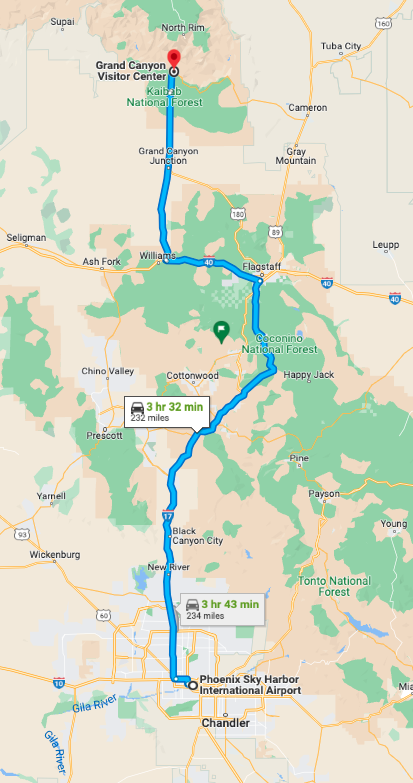
There are a couple of ways to get to the Grand Canyon, all of which are relatively fuss-free. The most convenient is by car, which will give you the freedom to explore the park as you choose.
The nearest major airport is Pheonix Sky Harbor Airport (PHX), a little under 4 hours away from the South Rim. You could also fly into Flagstaff Pulliam Airport (FLG), which is a smaller commercial airport just 90 minutes from the South Rim, by car.
The Grand Canyon Railway offers a scenic ride from Williams, Arizona, to the Grand Canyon Depot. There is also a bus that goes from Flagstaff to the Grand Canyon Village.
Another relaxed option is to book a tour. There are options from various nearby cities, including Las Vegas, Phoenix, and Flagstaff.
Getting Around Inside Grand Canyon National Park

Once inside the Grand Canyon National Park, you have a couple of options to get you where you want to go. The most common is by car, as the park has mostly well-maintained roads with various access points. A more eco-friendly option is the free shuttle bus, which stops at various points of interest along the south rim.
If you’d like to get below the canyon rim or down to the canyon floor, your legs are going to carry you there. The various hiking trails offer something for every fitness level. If you’re keen, you could take a mule ride into the depths to see the canyon for a unique experience.
Where to Stay to See the Grand Canyon in One Day
There are various lodgings and canyon campgrounds inside the park, but they do lean toward the pricey side and are often booked up well in advance. You can stay just outside the park, so you’ll still have easy access to the park. Here are a few of my top picks.
Luxury | Squire Resort at the Grand Canyon
The Squire Resort at the Grand Canyon has everything you could possibly wish for. This elegant five-star hotel boasts an amazing four restaurants, two swimming pools, a gym, a gift shop, a game room, and a bowling alley. The fact that it’s only a 10-minute drive from the Grand Canyon National Park makes this oasis an ideal base for your Grand Canyon day trip.
The beautifully decorated rooms are well-appointed, and the activities and entertainment available will keep everyone busy. To top it all off, the hotel is pet-friendly, so your beloved fur babies don’t have to stay at home. >>>Check Availability
Midrange | Holiday Inn Express & Suites Grand Canyon, An IHG Hotel
The Holiday Inn Express and Suites is a welcome rest spot for your adventures of the day. One of the standout features of this hotel is the indoor pool and cozy hot tub, perfect for relaxing tired muscles.
The rooms are simply furnished but beautiful and offer everything you could need. The hotel is a stone’s throw away from the Grand Canyon South Rim and close enough to Tusayan’s city center to make finding dining and entertainment a breeze. >>>Check Availability
Budget | Grand Canyon Plaza Hotel
The Grand Canyon Plaza Hotel is a perfect option for comfort on a budget. The hotel features a seasonal pool, an on-site restaurant, and an indoor spa. The rooms boast the usual amenities, complete with free Wi-Fi.
The views are spectacular, and you’ll be glad to know that this lovely Tusayan Hotel is only a little over six miles from the Grand Canyon South Rim. >>>Check Availability
Camping: Under Canvas Grand Canyon
Located in Valle, Arizona, Under Canvas Grand Canyon offers a camping experience like no other. You’ll be able to experience the best of nature without missing the trappings of home. Under Canvas is also a mere 25 minutes from the South Rim Grand Canyon entrance.
The safari-style private canvas tents provide luxurious privacy while fulfilling all the delights of a camping trip. The establishment has an on-site restaurant, optional en suite bathrooms, enticing activities, and comfortable furnishings. >>>Check Availability
Grand Canyon One-Day Tours
- Las Vegas: Grand Canyon, Antelope Canyon, Horseshoe Bend
- The Grand Canyon classic tour from Sedona, AZ
- Grand Canyon South Rim: Self-guided audio driving tour
- From Pheonix: Grand Canyon with Sedona day tour
Tips for Visiting the Grand Canyon in One Day

- Be patient —- the busy crowds might make movement or service slower, so don’t lose your cool.
- Be prepared —- carry water, salty snacks, and sunscreen. There isn’t always water available along the way, so make sure you have enough.
- Wear layers — due to the elevation of the Grand Canyon, the weather can be unpredictable.
- Leave no trace —- remember the principles of Leave No Trace to preserve the beauty of the park.
- Respect the wildlife —- brush up on your wildlife safety tips to keep yourself and the animals safe.
Kaibab vs the Bright Angel Trail | Which Trail Should You Take

While the Bright Angel Trail is wildly popular, and both trails offer unbelievable vistas, I’d suggest the Kaibab trail over the Bright Angel.
I found the views to be so much better in the beginning. If you hike the Bright Angel trail, you’ll likely have to hike all the way down to Plateau Point to get those promised scenic views.
Download my free Outdoor Photography Guide
Which Rims Should You Visit?

Each rim of the Grand Canyon has its own perks, so I would choose based on your preference. There are three rims, namely the south rim, the north rim, and the west rim. Grand Canyon East doesn’t actually have a rim, but it is still worth a visit, being the home of the picturesque Antelope Canyon and Horseshoe Bend.
The Grand Canyon’s South Rim is the most popular and has the most visitor facilities, in addition to its stunning views and hiking trails. It’s open throughout the year and is home to the historic Grand Canyon Village. The South Rim offers the most authentic experience and is generally considered the essence of the Grand Canyon.

The North Rim is quite remote and offers a more rugged experience, all in peace and quiet. It offers a new perspective on this iconic site, with forested views and wildlife abound. It’s only open between May and October due to the harsh winter conditions.
The West Rim is the closest to Las Vegas and is open year-round. You’ll find the famous Grand Canyon Skywalk here, as well as the opportunity to go white water rafting or boating. The West Rim and the Grand Canyon West region aren’t part of the National Park Service but are home to the Hualapai tribe. Grand Canyon West is managed by the tribe and offers insight into the colorful history of the tribe and the area.
What To Pack For Hiking The Grand Canyon

- Sunscreen: This is a no brainer. There are areas on the trail where there is no shade. Slather some on right before the trek. >Buy Sunscreen
- Hiking Boots/Shoes: If you use tennis shoes you can easily hurt your toes hitting a rock by accident (Trust me I have done it so many times before). >Check Out My Hiking Shoes
- Hiking socks: Having the correct socks helps you prevent getting blisters. Smart Wool is probably my favorite brand out there. I also love how they now have pink socks too 🙂 >Buy Hiking Socks
- Refillable water bottle: I always bring a Hydroflask on all my adventures. They are on the heavier side but I know for a fact they will not break. I have had a few cheap water bottles break on me before. There is no room for error at the Grand Canyon. >Check Prices Now
- Lots of water: The Grand Canyon is HOT. Bring a ton of water!
- Sunglasses: Like I said it can get pretty sunny.>Check Out These Sunglasses
- Snacks: The best snacks are jerky, nuts, energy bars. Cliff Bars are great for hiking.
- Trekking Poles: This is an optional product, but they really help with the knees. The poles I have listed are known to be one of the best in the market. >Buy The Trekking Poles Here
- Camera: I have linked the camera I used to take pictures of the Grand Canyon. The Sony A6000 is a great camera for people that want to start improving at travel photography. >Buy Sony Camera Here
- First Aid Kit: This is one of the first things I bought when I first started backpacking and camping. It is super portable. >Buy This Awesome First Aid Kit Here
- Day Pack: The REI bag I have linked, we have had for seven years now, and it is still going strong! >Buy This Great Quality Backpack
- Good hiking pants: These are probably the best hiking pants that I have found. They keep you dry in the crazy weather and they are durable. >Buy my hiking pants here
- Breathable sweat-wicking shirts: >Check This One Out
- Sports Bra: For women. >Buy One Here
- Jacket: Only in the winter >Buy My Favorite Jacket
- Base Layers: This is only needed in the winter. If you get chilly like me this is necessary! I have been using Smartwool for years now and they are my go-to base layers. >Buy the bottoms here, >Buy the top here
- National Park Pass: I highly recommend getting a year-long America The Beautiful Pass. >Get It Here
- Map: I love the National Geographic Maps! They are the best! >Buy One Here
Claim your FREE Hiking Checklist
Ready to start hiking? Grab my free hiking checklist and never forget anything at home!
FAQs About Visiting the Grand Canyon

Check out these commonly asked questions about the Grand Canyon.
Is Grand Canyon Worth Visiting?
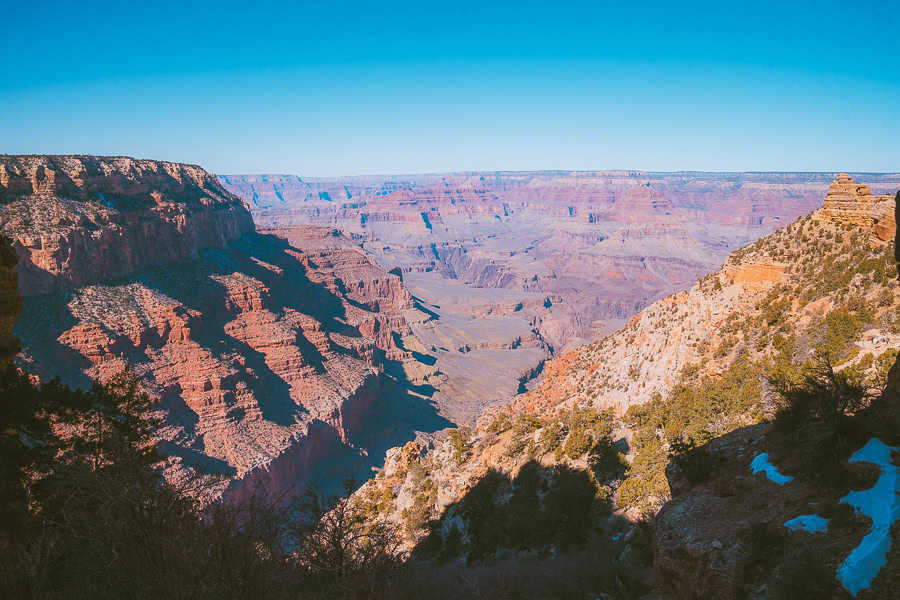
While the crowds and developed areas might be disheartening for some, you shouldn’t let that discourage you from visiting. The Grand Canyon’s beauty, history, and wonder definitely make it one of the best National parks to visit.
How Big Is the Grand Canyon?

As the longest canyon in the world, the Grand Canyon runs a mind-blowing 277 miles. It can get up to 18 miles wide and about a mile deep on average. The sheer size of this wondrous site is just one of the reasons it’s considered one of the seven natural wonders of the world.
Ready for Your Day in the Grand Canyon?

Now that you’re all clued up on all things Grand Canyon, you know that visiting this colossal site, even for just a day on your Arizona road trip, is a must. Aside from the views, the insight into the Earth’s geological history, as well as the people who once inhabited this canyon, are food for thought.
Whether you spend your day in the Grand Canyon hiking, exploring the attractions, or just enjoying the views, the memories you’ll make are worth every second.
What’s next: Planning a national park road trip? Read my guide on a scenic Utah National Parks road trip.

